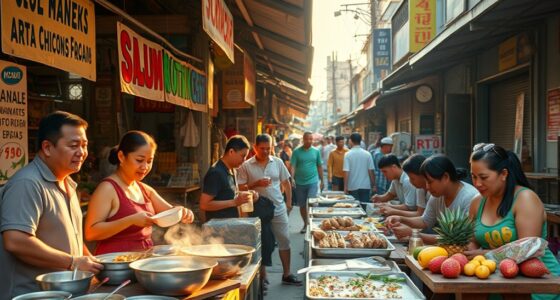Around the world, holiday food traditions bring people together and reflect each culture’s unique history and values. You might enjoy Italy’s sweet panettone, Japan’s layered osechi-ryori, or Germany’s mulled wine, each symbolizing prosperity, luck, or gratitude. Beverages like spiced chai, champagne, or eggnog create festive moods and foster closeness. If you want to explore more about these delicious customs, you’ll find fascinating stories behind each special dish and drink that make celebrations meaningful.
Key Takeaways
- Different cultures celebrate holidays with unique traditional foods that symbolize prosperity, luck, and gratitude.
- Regional delicacies like Italy’s panettone and Japan’s osechi-ryori reflect local ingredients and cultural history.
- Festive beverages such as mulled wine, eggnog, and spiced chai enhance holiday moods and foster social bonds.
- Food traditions during holidays strengthen family and community ties, creating lasting memories and cultural connections.
- Sharing special dishes and drinks during holidays signifies goodwill, unity, and appreciation across diverse cultures.

During the holiday season, food traditions bring families and communities together, creating lasting memories and reinforcing cultural heritage. You might find yourself enthusiastically anticipating special dishes and drinks that define this time of year in different parts of the world. One of the most fascinating aspects of holiday feasts is exploring regional delicacies that reflect local ingredients, climate, and history. For example, in Italy, panettone—a sweet, airy bread filled with candied fruits—is a staple, while in Japan, osechi-ryori offers beautifully arranged traditional foods in layered boxes. These regional treats aren’t just about flavor; they symbolize good fortune, prosperity, and gratitude, making the holiday meal a meaningful experience. As you savor these dishes, you connect with centuries-old customs, feeling a sense of continuity and pride in your cultural identity. Recognizing cultural heritage in these traditions highlights their importance in maintaining community bonds across generations.
Festive beverage customs also play an essential role in holiday celebrations. Whether it’s the warm glow of mulled wine in Germany, the rich spiced chai in India, or the bubbly toast of champagne in France, drinks help set the mood and bring people closer. You might find yourself raising a glass of eggnog in North America, spiced with cinnamon and nutmeg, or sipping on hot cocoa topped with whipped cream as you watch holiday movies. These beverages often carry their own stories and traditions, handed down through generations. For many, sharing a festive drink is a way to express goodwill, celebrate achievements, or simply enjoy each other’s company. The act of toasting, in particular, symbolizes unity and shared happiness, reinforcing bonds among family and friends.
Frequently Asked Questions
How Do Different Cultures Incorporate Local Ingredients Into Holiday Feasts?
You see how different cultures incorporate local ingredients into holiday feasts by using regional spice blends that highlight unique flavors. You might also notice local ingredient substitutions, like replacing imported spices with native ones, to make dishes more authentic and meaningful. This approach not only celebrates regional culinary heritage but also supports local farmers and preserves traditional cooking methods, making your holiday meals both festive and culturally rich.
What Are the Historical Origins of Popular Holiday Dishes Worldwide?
You might find that the historical influences behind popular holiday dishes stem from centuries-old traditions and cultural exchanges, shaping what we enjoy today. Culinary evolution, driven by trade routes, colonization, and local ingredients, transforms these dishes over time. For example, roasted meats or spiced desserts often have roots in ancient rituals or medieval customs, reflecting how history continuously influences and enriches our festive culinary celebrations.
How Have Modern Dietary Trends Influenced Traditional Holiday Menus?
Modern dietary trends have markedly shaped holiday menus by encouraging plant-based adaptations and gluten-free options. You might notice more vegan roasts or dairy-free desserts at celebrations, reflecting a shift toward healthier choices. These changes allow everyone to enjoy traditional flavors without compromising their dietary needs. By embracing these trends, you can create inclusive, festive meals that honor tradition while catering to contemporary preferences.
Are There Specific Etiquette Rules for Holiday Dining in Various Countries?
You’ll find that table manners and gift-giving customs vary widely across countries. For example, in Japan, it’s polite to bring a small gift and avoid sticking chopsticks upright in rice. In Italy, keeping hands visible on the table is customary. An interesting 65% of people say that understanding local etiquette enhances holiday celebrations, so you should research specific customs to show respect and enjoy your festive experience fully.
How Do Holiday Food Traditions Evolve With Globalization and Migration?
As globalization and migration influence you, holiday food traditions evolve through fusion cuisines and culinary adaptations. You’ll notice traditional dishes blend with new ingredients, creating unique flavors that honor both original roots and modern influences. This blending allows you to celebrate diverse cultural heritages, fostering inclusivity. Embracing these changes enriches your holiday experience, connecting you with a global community and highlighting how food brings people together across borders.
Conclusion
As you savor these global holiday dishes, remember they’re like colorful threads woven into the rich tapestry of tradition. Each bite tells a story, a melody of culture and history dancing on your palate. Embrace the flavors, the rituals, and the shared joy they bring. Let these festive feasts remind you that food isn’t just sustenance—it’s a celebration of connection, a warm hug across borders, uniting hearts in the universal language of holiday cheer.









